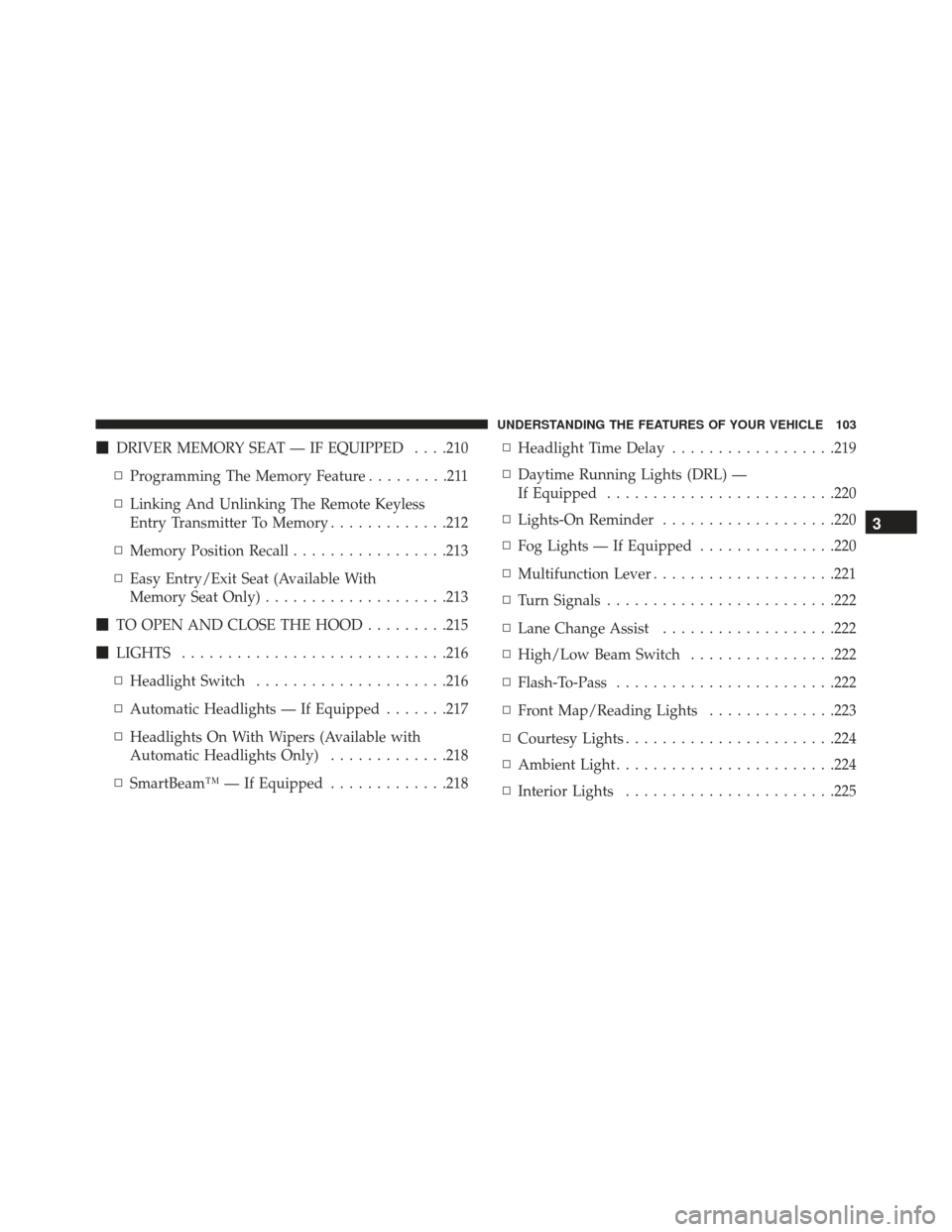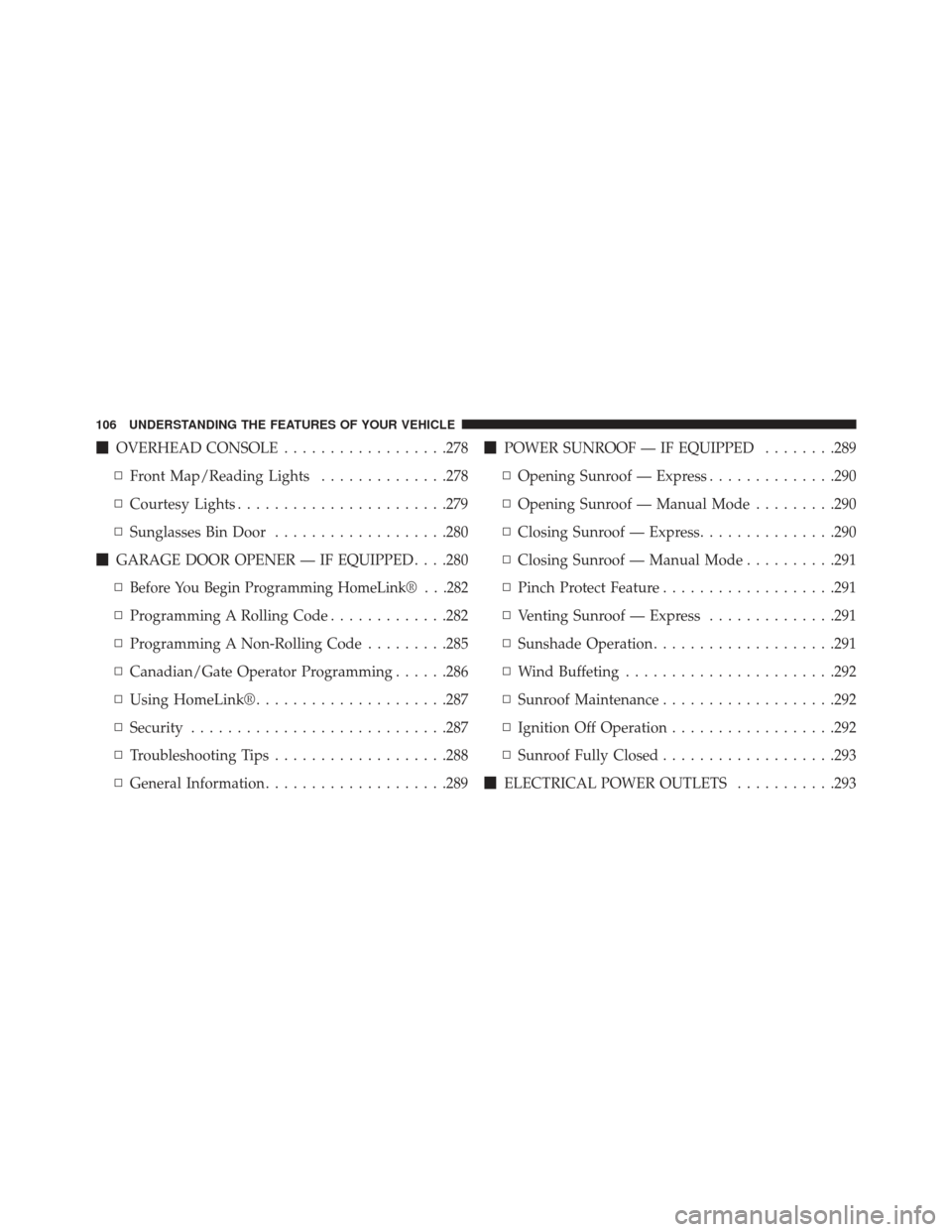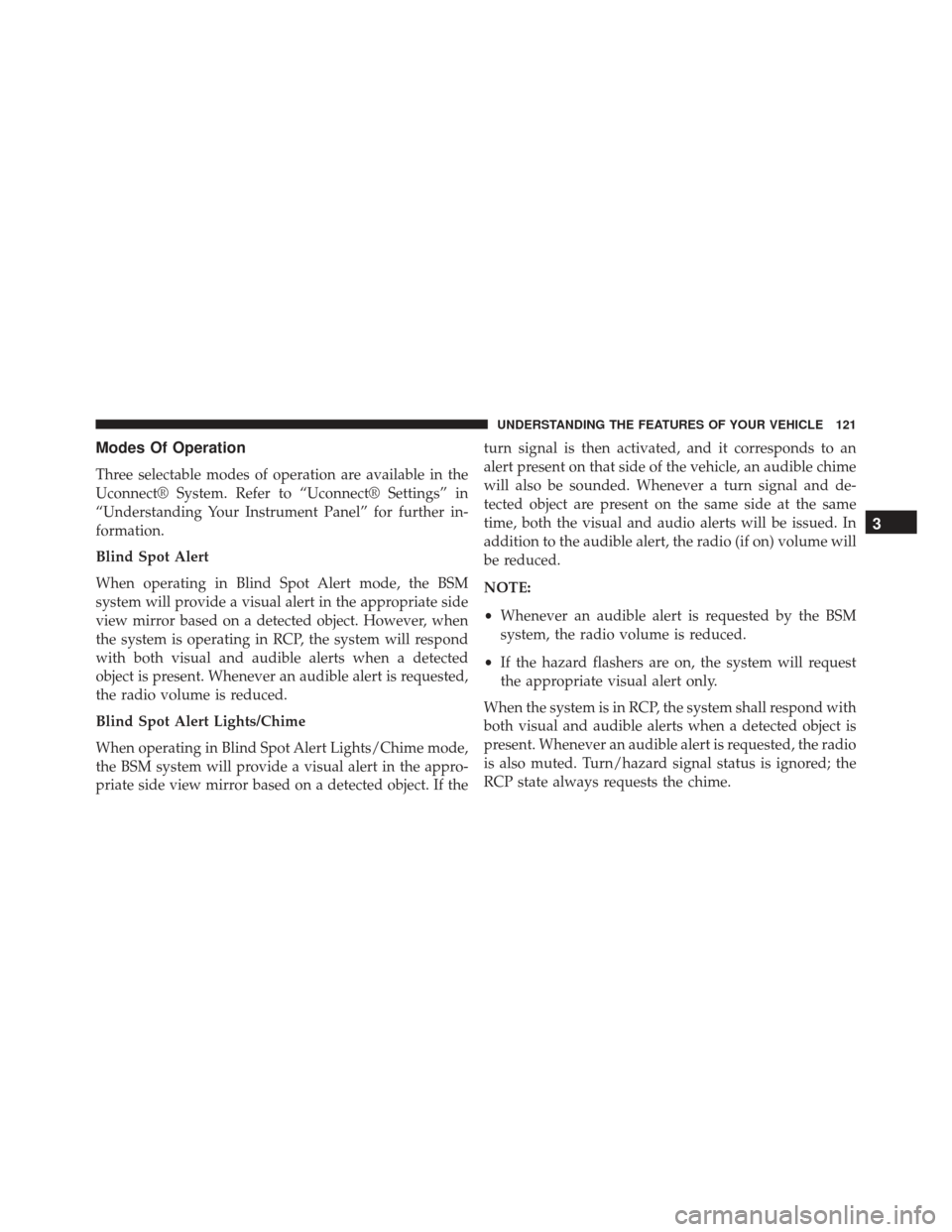Page 72 of 599

Because air bag sensors estimate deceleration over time,
vehicle speed and damage are not good indicators of
whether or not an air bag should have deployed.
Front And Side Impact Sensors
In front and side impacts, impact sensors can aid the ORC
in determining appropriate response to impact events.
Enhanced Accident Response System
In the event of an impact causing air bag deployment, if
the communication network remains intact, and the
power remains intact, depending on the nature of the
event the ORC will determine whether to have the
Enhanced Accident Response System perform the follow-
ing functions:
•Cut off fuel to the engine.
• Flash hazard lights as long as the battery has power or
until the ignition is cycled off. •
Turn on the interior lights, which remain on as long
as the battery has power or until the ignition key is
removed.
• Unlock the doors automatically.
In order to reset the Enhanced Accident Response System
functions after an event, the ignition switch must be
changed from IGN ON to IGN OFF.If A Deployment Occurs
The Advanced Front Air Bags are designed to deflate
immediately after deployment.
NOTE: In a rollover the pretensioners and/or SAB and
SABIC - if equipped air bags may deploy on both sides of
the vehicle.
If you do have a collision which deploys the air bags, any
or all of the following may occur:
70 THINGS TO KNOW BEFORE STARTING YOUR VEHICLE
Page 101 of 599
Periodic Safety Checks You Should Make Outside
The Vehicle
Tires
Examine tires for excessive tread wear and uneven wear
patterns. Check for stones, nails, glass, or other objects
lodged in the tread or sidewall. Inspect the tread for cuts
and cracks. Inspect sidewalls for cuts, cracks and bulges.
Check the wheel nuts for tightness. Check the tires
(including spare) for proper cold inflation pressure.
Lights
Have someone observe the operation of brake lights and
exterior lights while you work the controls. Check turn
signal and high beam indicator lights on the instrument
panel.
Door Latches
Check for positive closing, latching, and locking.
Fluid Leaks
Check area under vehicle after overnight parking for fuel,
engine coolant, oil, or other fluid leaks. Also, if gasoline
fumes are detected or if fuel, power steering fluid, or
brake fluid leaks are suspected, the cause should be
located and corrected immediately.
2
THINGS TO KNOW BEFORE STARTING YOUR VEHICLE 99
Page 105 of 599

�DRIVER MEMORY SEAT — IF EQUIPPED . . . .210
▫ Programming The Memory Feature .........211
▫ Linking And Unlinking The Remote Keyless
Entry Transmitter To Memory .............212
▫ Memory Position Recall .................213
▫ Easy Entry/Exit Seat (Available With
Memory Seat Only) ....................213
� TO OPEN AND CLOSE THE HOOD .........215
� LIGHTS ............................ .216
▫ Headlight Switch .....................216
▫ Automatic Headlights — If Equipped .......217
▫ Headlights On With Wipers (Available with
Automatic Headlights Only) .............218
▫ SmartBeam™ — If Equipped .............218▫
Headlight Time Delay ..................219
▫ Daytime Running Lights (DRL) —
If Equipped ........................ .220
▫ Lights-On Reminder ...................220
▫ Fog Lights — If Equipped ...............220
▫ Multifunction Lever ....................221
▫ Turn Signals ........................ .222
▫ Lane Change Assist ...................222
▫ High/Low Beam Switch ................222
▫ Flash-To-Pass ....................... .222
▫ Front Map/Reading Lights ..............223
▫ Courtesy Lights ...................... .224
▫ Ambient Light ....................... .224
▫ Interior Lights ...................... .225
3
UNDERSTANDING THE FEATURES OF YOUR VEHICLE 103
Page 106 of 599

�WINDSHIELD WIPERS AND WASHERS ......227
▫ Intermittent Wiper System ...............227
▫ Wiper Operation ..................... .227
▫ Windshield Washers ...................228
▫ Mist Feature ........................ .229
▫ Headlights On With Wipers (Available with
Automatic Headlights Only) .............229
▫ Rain Sensing Wipers — If Equipped ........229
� TILT/TELESCOPING STEERING COLUMN . . .231
� POWER TILT/TELESCOPING STEERING
COLUMN — IF EQUIPPED ...............232
�
HEATED STEERING WHEEL — IF EQUIPPED . .233
� ADJUSTABLE PEDALS — IF EQUIPPED ......235�
ELECTRONIC SPEED CONTROL —
IF EQUIPPED ........................ .237
▫ To Activate ......................... .238
▫ To Set A Desired Speed .................238
▫ To Deactivate ....................... .239
▫ To Resume Speed .....................239
▫ To Vary The Speed Setting ...............239
▫ To Accelerate For Passing ................240
� ADAPTIVE CRUISE CONTROL (ACC) —
IF EQUIPPED ........................ .241
▫ Adaptive Cruise Control (ACC) Operation . . . .243
▫ Activating Adaptive Cruise Control (ACC) . . . .244
▫ To Activate ......................... .245
104 UNDERSTANDING THE FEATURES OF YOUR VEHICLE
Page 108 of 599

�OVERHEAD CONSOLE ..................278
▫ Front Map/Reading Lights ..............278
▫ Courtesy Lights ...................... .279
▫ Sunglasses Bin Door ...................280
� GARAGE DOOR OPENER — IF EQUIPPED . . . .280
▫
Before You Begin Programming HomeLink® . . .282
▫ Programming A Rolling Code .............282
▫ Programming A Non-Rolling Code .........285
▫ Canadian/Gate Operator Programming ......286
▫ Using HomeLink® .....................287
▫ Security ........................... .287
▫ Troubleshooting Tips ...................288
▫ General Information ....................289 �
POWER SUNROOF — IF EQUIPPED ........289
▫ Opening Sunroof — Express ..............290
▫ Opening Sunroof — Manual Mode .........290
▫ Closing Sunroof — Express ...............290
▫ Closing Sunroof — Manual Mode ..........291
▫ Pinch Protect Feature ...................291
▫ Venting Sunroof — Express ..............291
▫ Sunshade Operation ....................291
▫ Wind Buffeting ...................... .292
▫ Sunroof Maintenance ...................292
▫ Ignition Off Operation ..................292
▫ Sunroof Fully Closed ...................293
� ELECTRICAL POWER OUTLETS ...........293
106 UNDERSTANDING THE FEATURES OF YOUR VEHICLE
Page 123 of 599

Modes Of Operation
Three selectable modes of operation are available in the
Uconnect® System. Refer to “Uconnect® Settings” in
“Understanding Your Instrument Panel” for further in-
formation.
Blind Spot Alert
When operating in Blind Spot Alert mode, the BSM
system will provide a visual alert in the appropriate side
view mirror based on a detected object. However, when
the system is operating in RCP, the system will respond
with both visual and audible alerts when a detected
object is present. Whenever an audible alert is requested,
the radio volume is reduced.
Blind Spot Alert Lights/Chime
When operating in Blind Spot Alert Lights/Chime mode,
the BSM system will provide a visual alert in the appro-
priate side view mirror based on a detected object. If theturn signal is then activated, and it corresponds to an
alert present on that side of the vehicle, an audible chime
will also be sounded. Whenever a turn signal and de-
tected object are present on the same side at the same
time, both the visual and audio alerts will be issued. In
addition to the audible alert, the radio (if on) volume will
be reduced.
NOTE:
•
Whenever an audible alert is requested by the BSM
system, the radio volume is reduced.
• If the hazard flashers are on, the system will request
the appropriate visual alert only.
When the system is in RCP, the system shall respond with
both visual and audible alerts when a detected object is
present. Whenever an audible alert is requested, the radio
is also muted. Turn/hazard signal status is ignored; the
RCP state always requests the chime.
3
UNDERSTANDING THE FEATURES OF YOUR VEHICLE 121
Page 205 of 599

NOTE:Once a heat setting is selected, heat will be felt
within two to five minutes.
When the HI-level setting is selected, the heater will
provide a boosted heat level during the first four minutes
of operation. Then, the heat output will drop to the
normal HI-level. If the HI-level setting is selected, the
system will automatically switch to LO-level after a
maximum of 60 minutes of continuous operation. At that
time, the display will change from HI to LO, indicating
the change. The LO-level setting will turn OFF automati-
cally after a maximum of 45 minutes.
Vehicle Equipped With Remote Start
On models that are equipped with remote start, the
driver ’s heated seat can be programmed to come on
during a remote start. Refer to “Remote Starting System
— If Equipped” in “Things To Know Before Starting Your
Vehicle” for further information.Rear Heated Seats
On vehicles equipped with rear heated seats, the seats
closest to the doors are heated. The controls for these
seats are located on the rear of the center console.
You can choose from HI, LO or OFF heat settings. Amber
indicator lights in each switch indicate the level of heat in
use. Two indicator lights will illuminate for HI, one for
LO and none for OFF.
Press the switch once to select HI-level heating.
Press the switch a second time to select LO-
level heating. Press the switch a third time to
shut the heating elements OFF.
If the HI-level heating is selected, the system will auto-
matically switch to LO-level heating after approximately
30 minutes of continuous operation. At that time, the
number of indicators illuminated changes from two to
3
UNDERSTANDING THE FEATURES OF YOUR VEHICLE 203
Page 218 of 599
CAUTION!
To prevent possible damage, do not slam the hood to
close it. Lower the hood until it is open 8 in (20 cm)
approximately and then drop it. This should secure
both latches. Never drive your vehicle unless the
hood is fully closed, with both latches engaged.
WARNING!
Be sure the hood is fully latched before driving your
vehicle. If the hood is not fully latched, it could open
when the vehicle is in motion and block your vision.
Failure to follow this warning could result in serious
injury or death.
LIGHTS
Headlight Switch
The headlight switch is located on the left side of
the instrument panel. This switch controls the
operation of the headlights, parking lights, instru-
ment panel lights, instrument panel light dimming, inte-
rior lights and fog lights.
216 UNDERSTANDING THE FEATURES OF YOUR VEHICLE